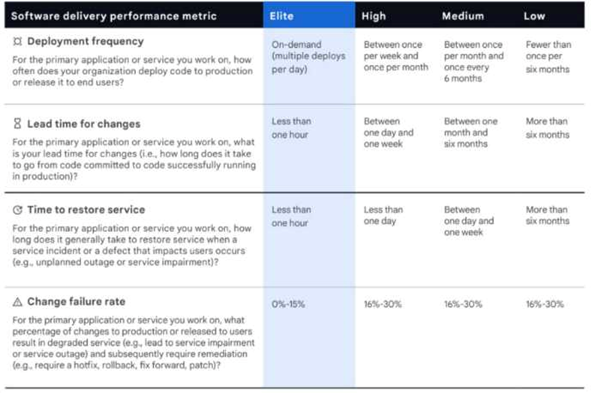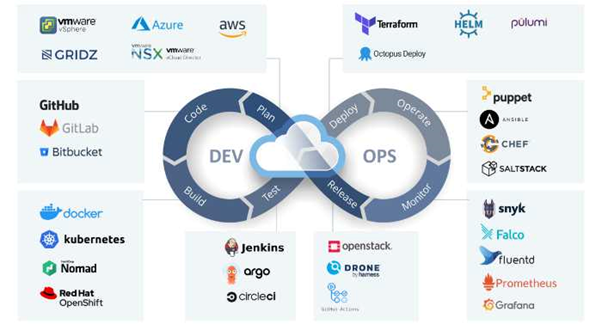Improving Agility and Staying Competitive with DevOps

The business landscape is constantly evolving, and SaaS companies and software developers that want to stay competitive need to be agile enough to adapt quickly. One way to achieve this agility is through the adoption of DevOps practices. DevOps is a software engineering philosophy that encourages communication, collaboration, and integration between software development and operation teams. By breaking down the barriers between these two groups, DevOps helps organizations improve their agility. For example, DevOps leads to faster turnaround times for new features, more reliable releases, and better responsiveness to customer needs.
But embracing DevOps can be a daunting task, especially for organizations that are used to working in a more traditional waterfall development model. In this whitepaper, we discuss some of the key benefits of DevOps and offer tips and tools for making the transition to a DevOps-led organisation.
What Are the Benefits of DevOps?
Let's delve a bit deeper into the benefits of DevOps that lead to greater agility and competitiveness.
- Increased Collaboration and Shared Responsibility: DevOps encourages team members to collaborate on all aspects of the software delivery process, from development through operations. Each member is responsible for the quality of their work and that of other teams.
- Automated Workflows: DevOps promotes continuous improvement by making builds more efficient and automation a priority. It means less manual work and fewer errors from switching from one tool to another throughout the build process, speeding up product release cycles.
- Open Communication: DevOps derives its name from "development" and "operations," so it's no surprise that communication between these two groups is critical for DevOps success. It aims to help organisations break down barriers between development teams and operations teams, helping employees talk to each other and allowing software updates to be carried out more quickly.
- Improved Security: DevOps encourages a culture in which everyone is responsible for the product's security. It also promotes a collaborative environment dedicated to finding and fixing bugs as soon as they're discovered. This can lead to improved code quality and prevent potential attacks against an app or platform due to holes in the codebase.
- Continuous Improvement: DevOps teams don't wait until all development is completed before testing their apps or updating them with new features. Rather, DevOps promotes short test cycles and frequent releases to address issues quickly, and customers are kept satisfied. Continuous improvement means DevOps leads to greater agility for your organisation over time.
- Faster time to value: DevOps ensures that applications are delivered to the customer as quickly as possible, which means DevOps teams can help your company deliver a better product more quickly. It allows for a more streamlined and efficient software development process that will ultimately lead to a faster time-to-market.
- Increased innovation capacity: DevOps can set your company up for success by allowing your developers to focus on innovation rather than spending valuable time addressing basic infrastructure needs. DevOps frees them up to be creative, and further develop the product without worrying about technical roadblocks or delays in the release process.
- Better customer experience: DevOps helps create a better customer experience by allowing your team to quickly deliver on the product roadmap with high quality and capability. DevOps creates an environment of transparency that delivers updates to customers frequently and reliably.
If you're still in doubt about the benefits of DevOps, consider the Accelerate State of DevOps reports that have surveyed more than 32,000 IT professionals over the last seven years. The reports have consistently found that "excellence in software delivery and operational performance drives organizational performance in technology transformation." According to the 2021 report, "elite performers continue to accelerate their pace of software delivery, increasing their lead time for changes from less than one day to less than one hour. Not only that but elite performers:
- Deploy 973x more frequently than low performers
- Have a 6570x faster lead time to deploy
- Have a 3x lower change failure rate,
- Have an impressive 6570x faster time-to-recover from incidents when failure does happen."
(Image source: Google Cloud's DevOps Research and Assessment (DORA) team)
When comparing low performers to elite ones, the latter can constantly demonstrate organisational success with DevOps
Cultural Changes to Bring DevOps to Life
Unfortunately, DevOps adoption is easier said than done. So, what do you require to bring DevOps to life in your organisation? As with most successful organisational changes, you need a complete cultural change – a paradigm shift in the attitudes and behaviours of employees. DevOps, after all, does not deliver benefits unless your entire organization makes it a priority and commits to its success.
Mindset
The first step is changing the mindset. DevOps is not just about software engineers automating processes – DevOps requires everyone to adopt a culture of collaboration and shared responsibility. Everyone must work together towards a common goal, fostering agility by developing and deploying products faster than ever before, while maintaining high quality and productivity across teams. This includes software developers and testers, QA engineers, system administrators, release managers, product managers – all members of the DevOps value chain need to be on board if DevOps is going to succeed.
Organisations also need to apply design thinking. Design thinking focuses on user experience while creating a product that delivers value to customers. DevOps should be motivated by the same philosophy – teams must develop products that offer maximum value to their users. DevOps is about velocity, but it's also focused on quality. It requires team members to have good technical skills and understand their customers' needs to develop solid products that will achieve success in the marketplace.
Processes
Building DevOps processes may be one of your organisation's greatest challenges when adopting DevOps. However, adopting several new processes will hasten your journey towards a DevOps culture.
- Think "Infrastructure as code": To improve velocity, teams must build and deploy software faster than ever before. This may mean shedding expensive hardware and scaling up or out through virtualisation tools. You must also automate time-consuming processes like manual infrastructure setup. Infrastructure as code is the answer, as it allows you to deploy infrastructure quickly using software development practices by treating it as code.
- Agile software development: An agile approach to developing applications allows for faster time-to-market. DevOps teams should adopt agile methodologies that embrace change rather than fighting it, focus on delivering working products frequently, and value responsiveness over following a lengthy plan. This means embracing constant feedback from customers, integrating with other services (APIs), shortening release cycles (lowering the time between releases), and iterating fast (frequent deployments).
- Improvements in Automation: Automation is at the core of DevOps. Automating your infrastructure and processes allows teams to release products faster, more frequently, and with fewer problems because it reduces manual errors, which is key to accelerating velocity. However, for automation to be successful, organisations must adopt automated configuration management tools that can securely manage change across many systems quickly and maintain consistency in the deployment process.
- Continuous Integration: Evolutionary design patterns encourage collaboration between software development teams using continuous integration and frequent automatic testing by an almost continuous build process. Continuous integration helps team members identify issues early on when they are still manageable rather than letting them accumulate until a much larger problem occurs down the line.
- Continuous Delivery: In a DevOps environment, teams carry out more deployments than traditional environments. Continuous delivery helps these deployments go smoothly rather than being error-prone events with many manual steps. However, improving your continuous delivery process requires building a culture of automation across the organisation.
- Continuous Deployment: Implementing CI/CD systems allows teams to automatically build and test the software before it's deployed into production. This eliminates errors caused by manual processes that allow code that breaks or is not ready for release to slip into production – one of the primary causes of downtime. It also makes deployment an event that happens continuously rather than just once at the end of a development cycle – another key source of downtime.
DevOps Tools
The last cultural change to bring DevOps to life is to invest in the right tools. DevOps tools and software are essential for improving management, development, and operations collaboration during the software development process. According to a study published by Verified Market Research, the global DevOps solutions and services market is anticipated to expand to US$20.01 billion in 2026 at a CAGR of 24.7% from 2019 to 2026.
(Image source: Verified Market Research)
Businesses are increasingly interested in using DevOps to establish a more agile and efficient IT workforce. This demand is projected to increase rapidly as companies recognise the power of DevOps for accelerating software development.
There are dozens of DevOps tools and solutions for every area of DevOps work, such as version control, continuous improvement, and development (CI/CD), issue tracking, communications, containerisation, configuration management, virtual infrastructure, managed services, and much more.
Below are some tools you should consider as you transition to DevOps.
Git: Version Control and Distributed Source Code Management
DevOps encourages collaboration between development and operations teams, so a version control system that makes it easy for multiple people to share code is necessary. A DevOps team should use a distributed source code management tool like Github, Gitlab, and Bitbucket.
Jenkins: CI/CD and Deployment
DevOps teams need DevOps continuous integration (CI) tools to automate the processes of compiling code and deploying it. DevOps CI tools include Jenkins, CircleCI, Travis CI, GitLab CI, and Buildkite.
Jenkins is a popular Continuous Integration and Continuous Delivery (CI/CD) tool with software developers using it as an open-source platform for task automation during the whole software creation cycle (SDLC). Jenkins also manages traffic at the intersection of development, automation, release management, and more with integration for most of your DevOps needs.
Jira: Issue, Project Tracking and Communications Platform
A DevOps team needs issue tracking software for writing requirements and bug reports to prioritise tasks properly. In addition, DevOps teams must stay connected with project members using a DevOps communications platform. Jira is a great tool for DevOps teams who rely on issue tracking and collaboration features such as virtual whiteboards and instant messaging.
With Jira, you can plan projects, track work items in an agile workflow, make or release code changes through automation tools like Jenkins Pipeline, and visualise dependencies between tasks using reports and Kanban boards. You may also use reports and Kanban boards to represent task dependencies so your team can concentrate on what's essential while they collaborate.
Docker and Kubernetes: Containerisation Platforms
Containerisation is a process of isolating software from its environment. It packages an application and all its dependencies into a container unit. This makes it possible to move an application from one environment to another without affecting the application or its dependencies.
Containerisation platforms – such as Docker and Kubernetes – can improve DevOps collaboration by automating the deployment of applications across different DevOps tools. DevOps can use containers to deploy software and then configure them as needed. Teams may choose from several types of containers, including virtual machines and bare-metal containers.
Docker containers are one of the most popular DevOps tools today. It is simple to create new services or migrate existing apps into a container environment without worrying about infrastructure changes. In addition, you can quickly get your code up and running with pre-built images on hub.docker.com.
With Kubernetes, you can automatically deploy many containers (potentially thousands) and automate their management. When you reach a certain degree of complexity and need to scale your resources, Kubernetes is often the next logical step.
Red Hat Ansible Automation Platform: Configuration Management
DevOps teams should reduce manual configuration management efforts with a DevOps platform that automates routine tasks such as setting up your infrastructure. A good tool to do this is Ansible from Red Hat, which deploys software and provisions systems. It also allows you to set up and manage your remote computers from a central location.
Ansible is a fantastic option for DevOps automation because of its simplicity of use, gentle learning curve, and portability across Linux and Windows systems. It can also automate process administration activities such as user addition, package downloads, and configuration changes.
In addition, Ansible is an agentless software that uses SSH to connect with remote devices. Therefore, it functions properly without needing extra components or dependencies.
zsah DevOps: Virtual Infrastructure and Managed Services
Finally, you need a service to develop optimal environments to host your applications and manage your DevOps in the cloud.
zsah is a new breed of enterprise IT service provider based in the UK that combines on-demand virtual infrastructure with a managed DevOps service. Through this integration, zsah manages computing resources, automates tasks associated with Infrastructure as Code (IaC), facilitates continuous software delivery, and empowers product teams through collaboration features such as instant messaging and issue tracking. zsah also provides round-the-clock application support and investigatory skills in application performance and error fixing.
With zsah managing your entire DevOps ecosystem, your team can focus on what's most important – iterating quickly and developing the best possible products for your customers. zsah can help you create an optimal environment for DevOps collaboration to meet business objectives while staying on time and under budget.
To learn more about how zsah can bring DevOps to life in your organisation, reach out to one of our team members today!




